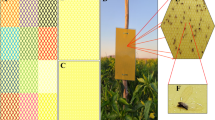Abstract
We tested two marking techniques for adult small hive beetles (SHB): dusting and thoracic notching. The use of blue and red chalk dusts to mark beetles was not persistent and caused early death of SHB with an average survival of 52.6 ± 23.8 and 13.9 ± 7.3 days, respectively. In contrast, notched beetles survived longer (mean = 353.6 ± 5.3 days) with the last beetle dying after 383 days. Likewise, notched beetles (presumed to be injured because of oozing hemolymph from the notched area) also lived long with an average of 193.6 ± 38.8 days. Notching also resulted in a high rate of recovery; 81% for beetles introduced directly into a nucleus colony, and 59% and 66% for a nucleus colony and pole traps, respectively, for beetles released inside a screen tent. These high recovery rates confirmed that notching did not interfere with the beetles’ ability to fly. However, it appeared that notched females laid more eggs than those that were not notched both with multiple (171.70 ± 11.20 vs 126.87 ± 10.27 eggs per day) and single (70.02 ± 5.45 vs 57.97 ± 5.12 eggs per day) pairs for a period of 1–3 days. Whether or not notching affects lifetime fecundity of females was not assessed in this study. Nevertheless, notching is a permanent mark for SHB and thus, may be useful in many ecological studies or in studying the efficacy of lures and traps for SHB control.


Similar content being viewed by others
References
Arbogast, R.T., Torto, B., van Englesdorp, D., Teal, P.E.A. (2007) An effective trap and bait combination for monitoring the small hive beetle, Aethina tumida (Coleoptera: Nitidulidae). Fla. Entomol. 90, 404–406
Bailey, B.A., Martin, R.J., Downer, R.G.H. (1983) Haemolymph octopamine levels during and following flight in the American cockroach, Periplaneta americana. Can. J. Zool. 62, 19–22
Connor, L. (2011) Wipe out! the big island in crisis. Bee Cult. 139, 56–60
Davenport, A.P., Evans, P.D. (1984) Stress-induced changes in the octopamine levels of insect haemolymph. Insect Biochem. 14, 135–143
de Guzman, L.I., Frake, A.M. (2007) Temperature effects on the life history of Aethina tumida (Coleoptera: Nitidulidae). J. Apic. Res. 46, 88–93
de Guzman, L.I., Frake, A.M., Rinderer, T.E., Arbogast, R.T. (2011) Effect of height and color on the efficiency of the small hive beetle (Coleoptera: Nitidulidae) pole traps. J. Econ. Entomol. 104, 26–31
Ellis, J.D., Neumann, P., Hepburn, H.R., Elzen, P.J. (2002) Longevity and reproductive success of Aethina tumida (Coleoptera: Nitidulidae) fed different natural diets. J. Econ. Entomol. 95, 902–907
Gangwere, S.K., Chavin, W., Evans, F.C. (1964) Methods of marking insects, with special reference to Orthoptera (Sens. Lat.). Ann. Entomol. Soc. Am. 57, 662–669
Geister, T.L., Lorenz, M.W., Hoffmann, K.H., Fischer, K. (2008) Effects of the NMDA receptor antagonist MK-801 on female reproduction and juvenile hormone biosynthesis in the cricket Gryllus bimaculatus and the butterfly Bicyclus anynana. J. Exp. Biol. 211, 1587–1593
Goldwasser, L., Schatz, G.E., Young, H.J. (1993) A new method for marking Scarabaeidae and other Coleoptera. Coleopt. Bull. 47, 21–26
Gruntenko, N.E., Karpova, E.K., Alekseev, A.A., Chentsova, N.A., Bogomolova, E.V., Bownes, M., Rauschenbach, I.Y. (2007) Effects of octopamine on reproduction, juvenile hormone metabolism, dopamine, and 20-hydroxyecdysone contents in Drosophila. Arch. Insect Biochem. Physiol. 65, 85–94
Hagler, J.R., Jackson, C.G. (2001) Methods for marking insects: current techniques and future prospects. Annu. Rev. Entomol. 46, 511–543
Lundie A.E. (1940) The small hive beetle, Aethina tumida. Science Bulletin 220. Union of South Africa, Dept. of Agriculture and Forestry (Entomological Series #3). 30pp
Nolan IV, M.P., Hood, W.M. (2008) Mark, release, and recapture techniques for the small hive beetle. Am. Bee J. 48, 558–559
Orchard, I., Ramirez, J.M., Lange, A.B. (1993) A multifunctional role for octopamine in locust flight. Annu. Rev. Entomol. 38, 227–249
Polivka, J.B. (1949) The use of fluorescent pigments in a study of the flight of the Japanese beetle. J. Econ. Entomol. 42, 818–821
SAS Institute (2008) SAS user’s guide, version 9.2. SAS Institute, Cary
Savalli, U.M., Fox, C.W. (1999) The effect of male size, age, and mating behavior on sexual selection in the seed beetle Callosobruchus maculatus. Ethol. Ecol. Evol. 11, 49–60
Southwood, T.R.E., Henderson, P.A. (2000) Ecological Methods. Blackwell Science, Oxford
Taft, H.M., Agee, H.R. (1962) A marking and recovery method for use in boll weevil movement studies. J. Econ. Entomol. 55, 1018–1019
Winder, L. (2004) Marking by abrasion or branding and recapturing carabid beetles in studies of their movement. Int. J. Pest Manag. 50, 161–164
Woodring, J.P., Mcbride, L.A., Fields, P. (1989) The role of octopamine in handling and exercise-induced hyperglycaemia and hyperlipaemia in Acheta domesticus. J. Insect Physiol. 35, 613–617
Acknowledgment
We thank A. Prudente, T. Stelzer, J. Wales, and G. Delatte for their technical help. This research was completed in cooperation with the Louisiana Agricultural Experiment Station.
Author information
Authors and Affiliations
Corresponding author
Additional information
Manuscript editor: Peter Rosenkranz
Marquage des petits coléoptères des ruches par encoche thoracique: effets sur la longévité, l’aptitude au vol et la fécondité.
Aethina tumida / marquage / thorax / méthode de capture recapture / survie / fécondité / activité de vol
Markierungen des Kleinen Beutenkäfers durch Thoraxeinkerbungen.
Aethina tumida / Markierung / Kerbe / Wiederfang / Überlebensrate / Fekundität / Flugaktivität
Footnote
Mention of trade names or commercial products in this publication is solely for the purpose of providing specific information and does not imply recommendation or endorsement by the United States Department of Agriculture.
Rights and permissions
About this article
Cite this article
de Guzman, L.I., Frake, A.M. & Rinderer, T.E. Marking small hive beetles with thoracic notching: effects on longevity, flight ability and fecundity. Apidologie 43, 425–431 (2012). https://doi.org/10.1007/s13592-011-0107-8
Received:
Revised:
Accepted:
Published:
Issue Date:
DOI: https://doi.org/10.1007/s13592-011-0107-8




